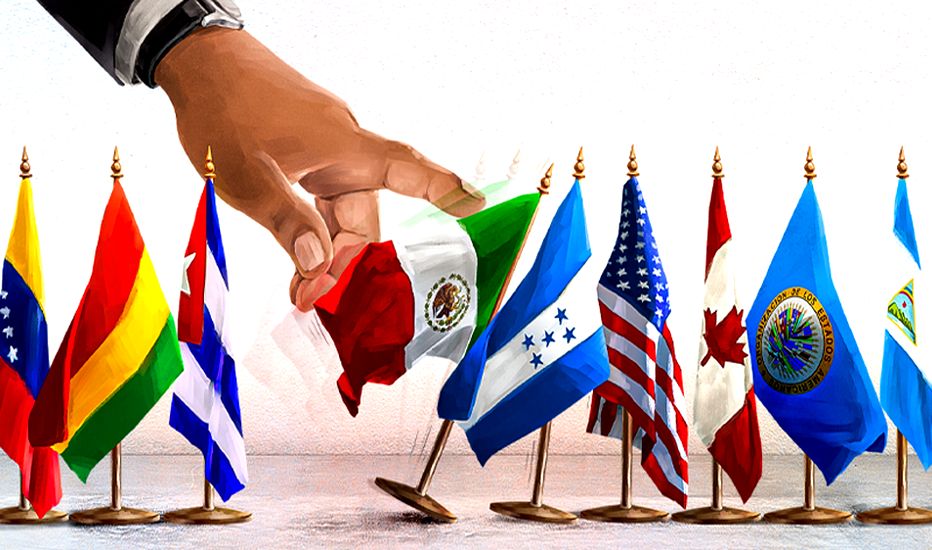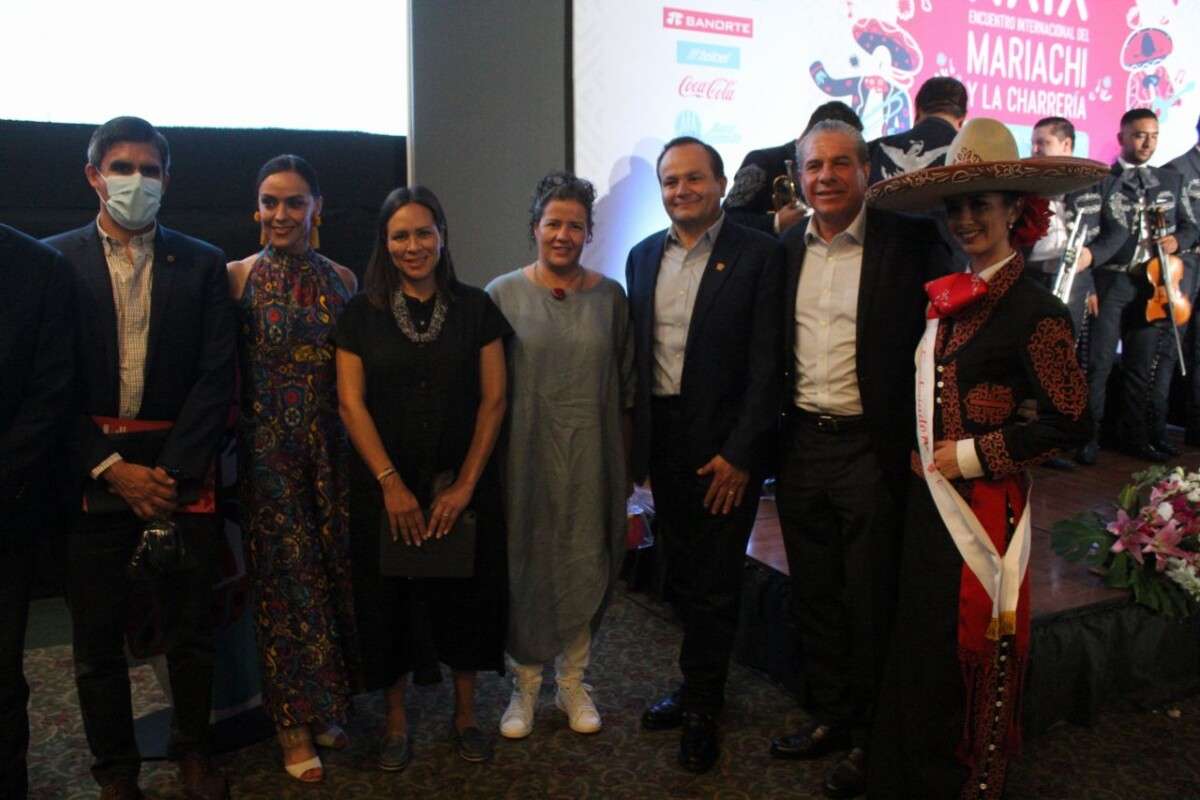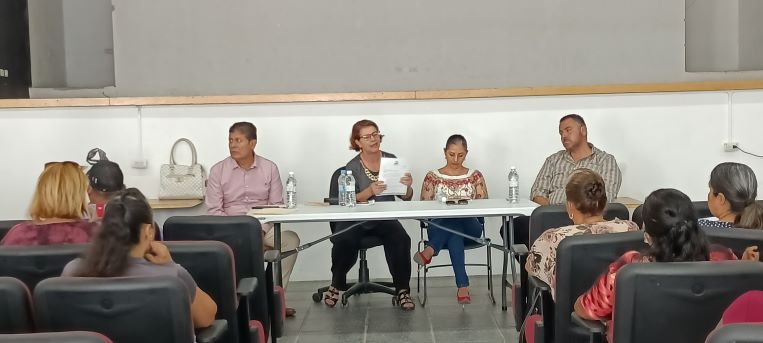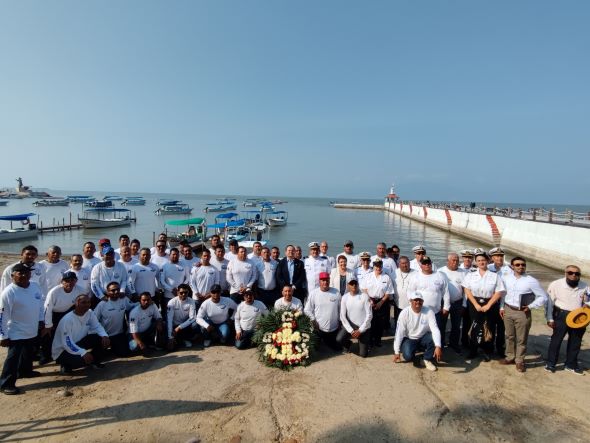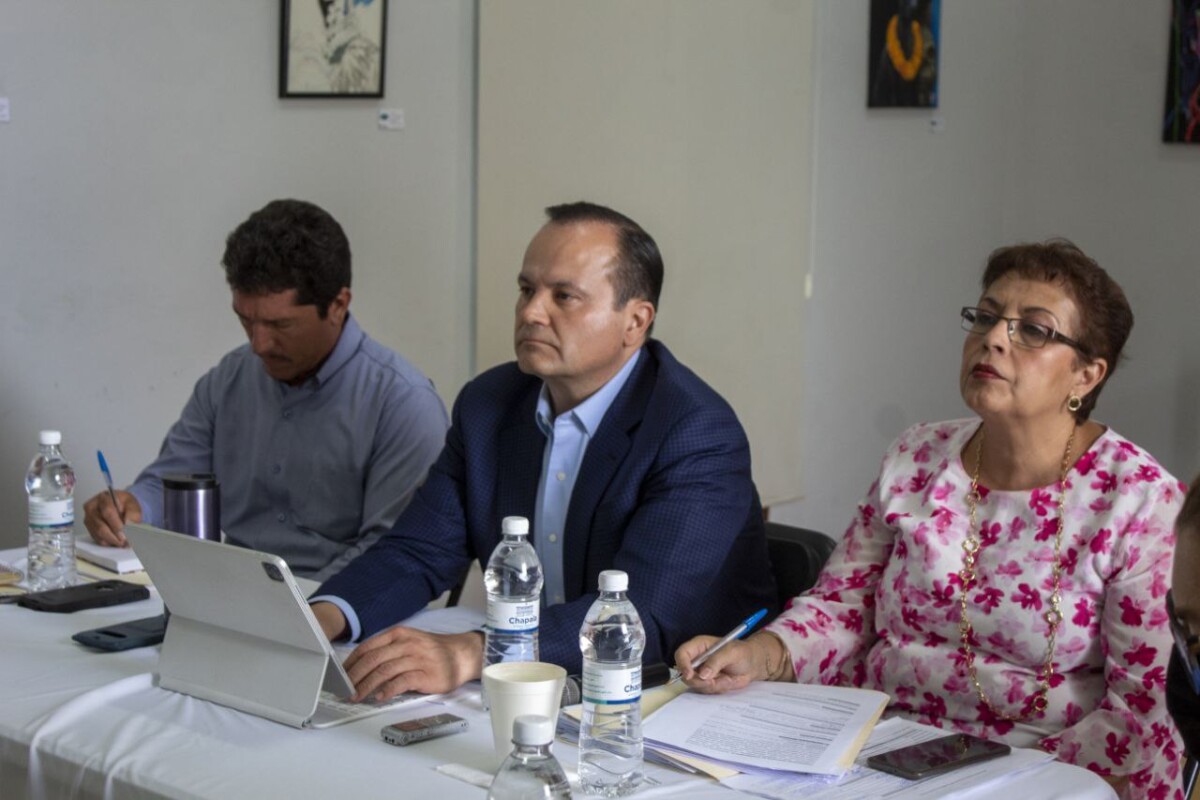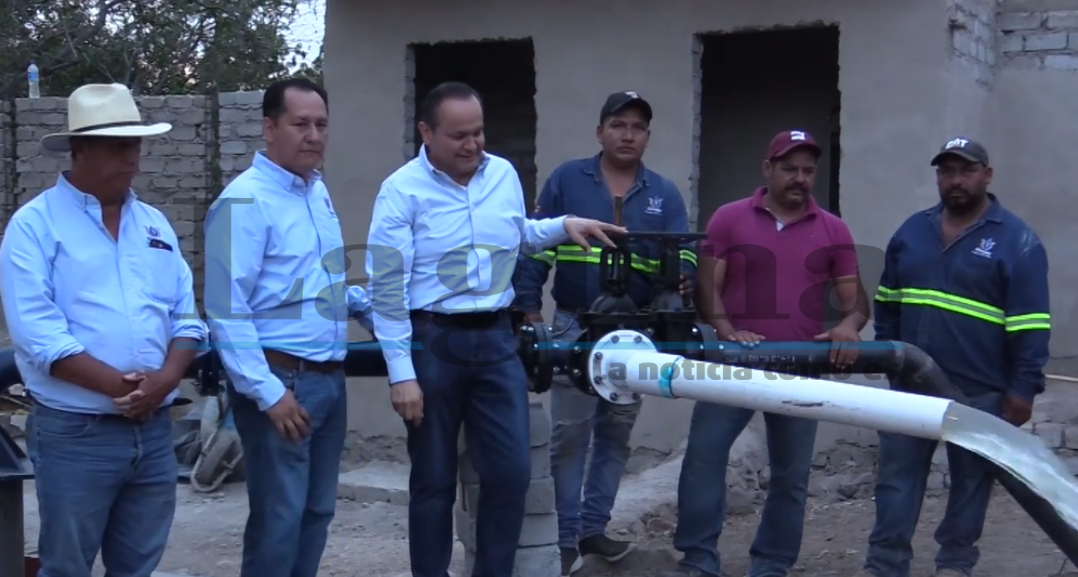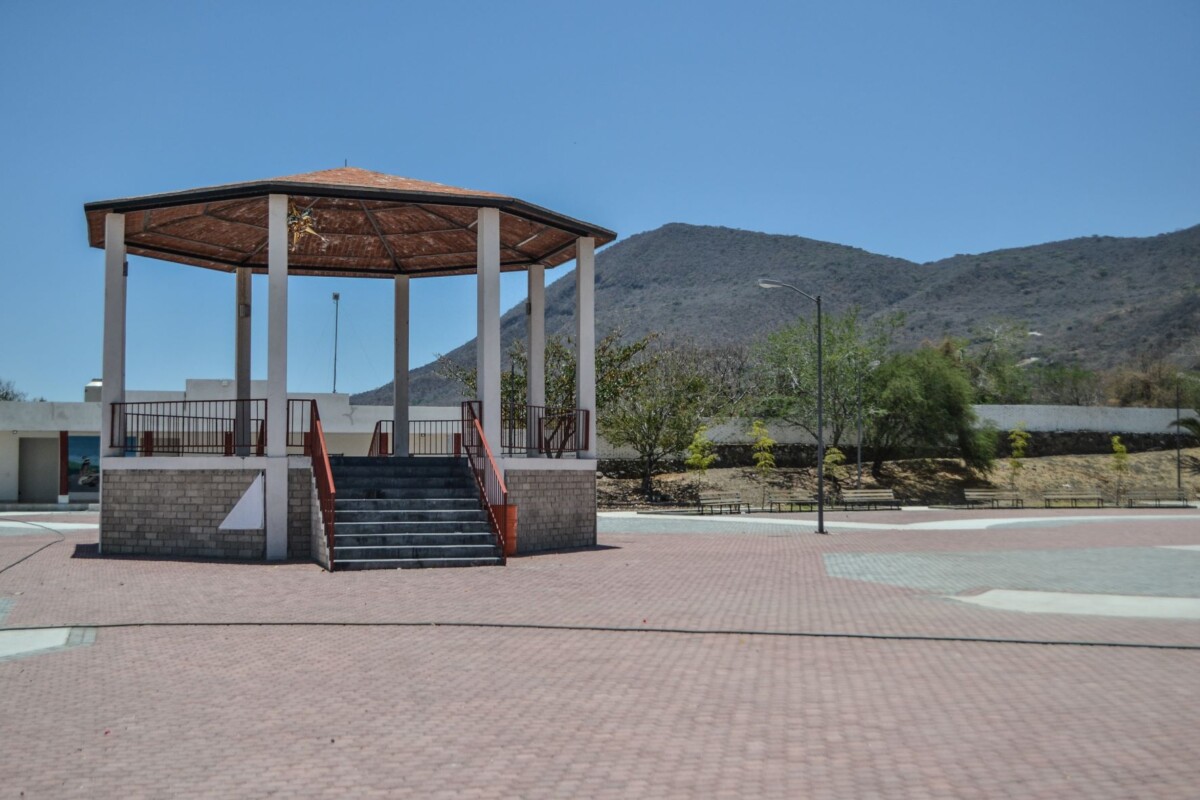Gobierno
Opinion: From North to South
With no clear results since the first Summit of the Americas, the presidents of the American nations are meeting in the United States for its next round, minus Cuba, Venezuela and Nicaragua and Mexico. Photo: Courtesy.
By: Abigail A. Correa Cisneros
The various issues discussed at the Summit of the Americas since its beginning in 1990, remain unresolved in the region. Currently pending are the two years of the Covid-19 pandemic, the climate crisis we are going through, and migration.
This meeting lacks, among other things, inclusion, after leaving out Nicaragua, Cuba and Venezuela and for which the President of Mexico said he will not attend. However, his representative will be the Foreign Minister, Marcelo Ebrard addressing the issue of Cuba and the blockade.
Every three years political leaders from all over the continent meet to discuss and define actions to face the problems and challenges shared by the region. It seems that little has been achieved. The region continues to experience problems of marginalization, migration, violence and economic problems.
In this meeting, the focus is on climate change. «Building a sustainable, resilient and equitable future» is the theme of the summit being held in the United States from June 6 to 10. Other topics to be discussed include democracy, human rights, justice, security, trade, disaster management, sustainable development, education, health, gender equality, connectivity, among others.
Since the summit has been taking place, the pending issues are becoming more and more important in the Americas. Nayar López Castellanos, the coordinator of the Center for Latin American Studies of the Faculty of Political and Social Sciences (FCPyS), considers that: «it has traditionally been a space created by the United States to generate a favorable environment for its interests and its hegemonic condition that has prevailed throughout history».
The researcher and academic secretary of the Center for Research on North America (CISAN), Juan Carlos Barrón Pastor, says that the idea of creating a summit to promote a sustainable, resilient and equitable future creates a set of ambiguities because it is not clear what it refers to. «Many analysts talk about issues such as pandemics, climate change, structural causes of migration and strengthening democracies. What is certain is that Biden is stalled in the Senate and the resources with which he intends to balance China’s investments in the region, are in doubt».
Much of what will be discussed during this summit in the United States has to do with its own political agenda. Joe Biden’s administration presented five projects related to strengthening health systems, addressing climate change, transitioning to clean energy, establishing a regional program for digital transformation and strengthening democratic governance. What remains to be determined is the budget that will be available for these purposes.
At the start of the summit, organizations called for respect for the rights of migrants and for a solution to this problem at its source, the problems that force them to leave their countries.
The Summit of the Americas should «generate specific regional agreements based on respect for human rights standards to guarantee safe transit and attend to the population in mobility, from the south to the north of the continent,» indicated more than 100 social organizations from Mexico.
AMLO’s government allowed the free transit of the caravan heading to the United States, with an estimated 15 thousand people heading north. The National Migration Institute (INM) will deliver humanitarian visas, exit permits and temporary cards so that they can move in the coming days.
The number of people exposes the problem that concerns even those absent from the Summit, because most of the migrants are from Cuba, Venezuela and Central America.
FROM THE CENTER
Ciudad Obregón, Sonora, will host the twelfth session of the Subcommittee on Aquaculture of the Committee on Fisheries of the Food and Agriculture Organization of the United Nations (FAO), to be held from March 7 to 10, 2023, said the Government of Mexico, through the Ministry of Agriculture and Rural Development in coordination with the National Commission of Aquaculture and Fisheries (Conapesca). Announcing the news at a press conference, the National Commissioner for Aquaculture and Fisheries, Octavio Almada Palafox, accompanied by Governor Alfonso Durazo Montaño, said he was convinced that Sonora and the whole country have a good opportunity to continue consolidating joint efforts among countries to achieve the objectives of the United Nations Organization, (UN), to reach agreements, add experiences for the welfare of Mexican fishing and aquaculture families and to promote the development of the Mexican fishing and aquaculture industry.
Translated by Sydney Metrick
Chapala will host 29th International Mariachi and Charrería Encounter events
The mayor of Chapala, accompanied by municipal officials and representatives of the Government of the State of Jalisco.
Editor.– The municipality of Chapala is one of the venues that will host the XXIX edition of the Encuentro Internacional del Mariachi y la Charrería to be held this year from August 25 to September 4 in different venues in the state of Jalisco to promote tourism outside the Metropolitan Area of Guadalajara (AMG).
Chapala President Aguirre announced at a press conference on the program of activities of the Encounter that Chapala will host a gala concert on Friday, August 26.
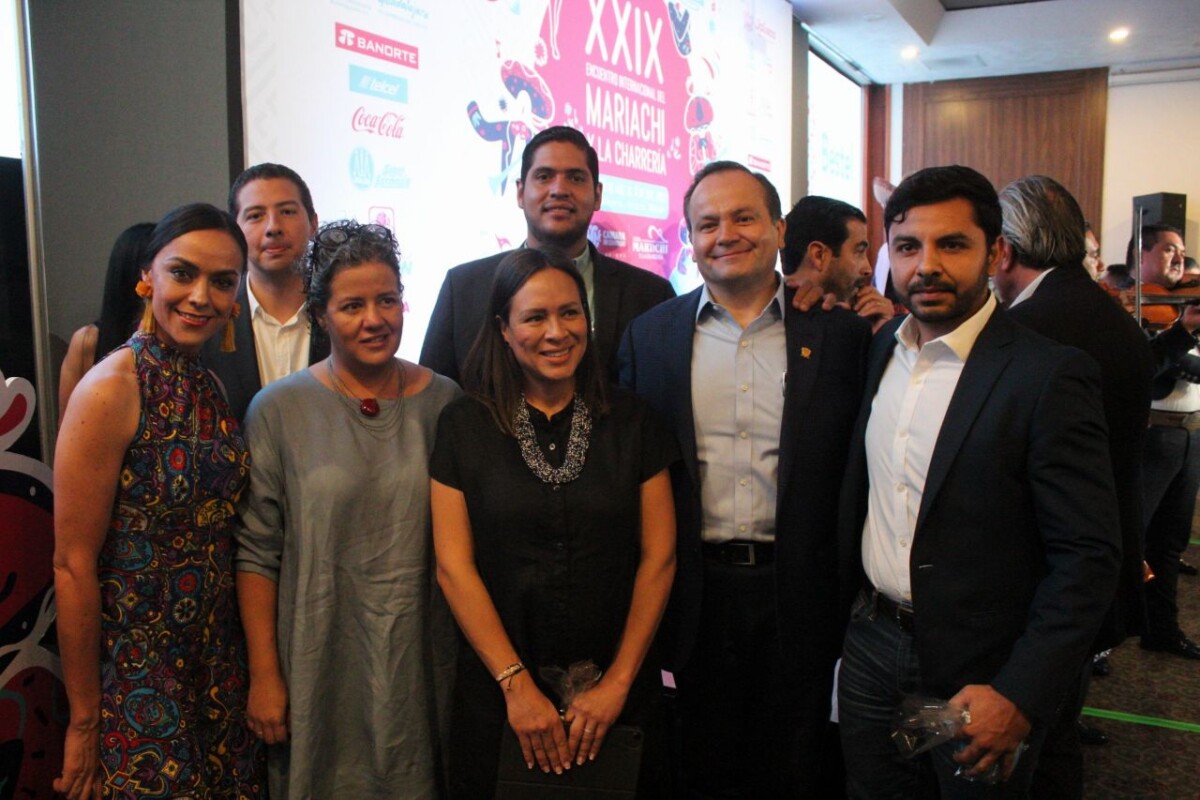
The Mayor of Chapala, accompanied by municipal officials, representatives of the Jalisco State Government and the Guadalajara Chamber of Commerce.
«One of the objectives of this Encounter is to extend to the municipalities of the state this celebration, so Chapala will host one of the events of this program. On Friday, August 26 we will have a gala concert in our municipality,» the mayor shared on his personal Facebook account.
In addition to the AMG, International Gala events will also be held in Puerto Vallarta, Cocula, Tequila, Mazamitla, Jocotepec and Tapalpa with the presentation of mariachis from countries such as Mexico, Colombia, Chile, United States, Bolivia, Israel, Peru, Ecuador and Dominican Republic.
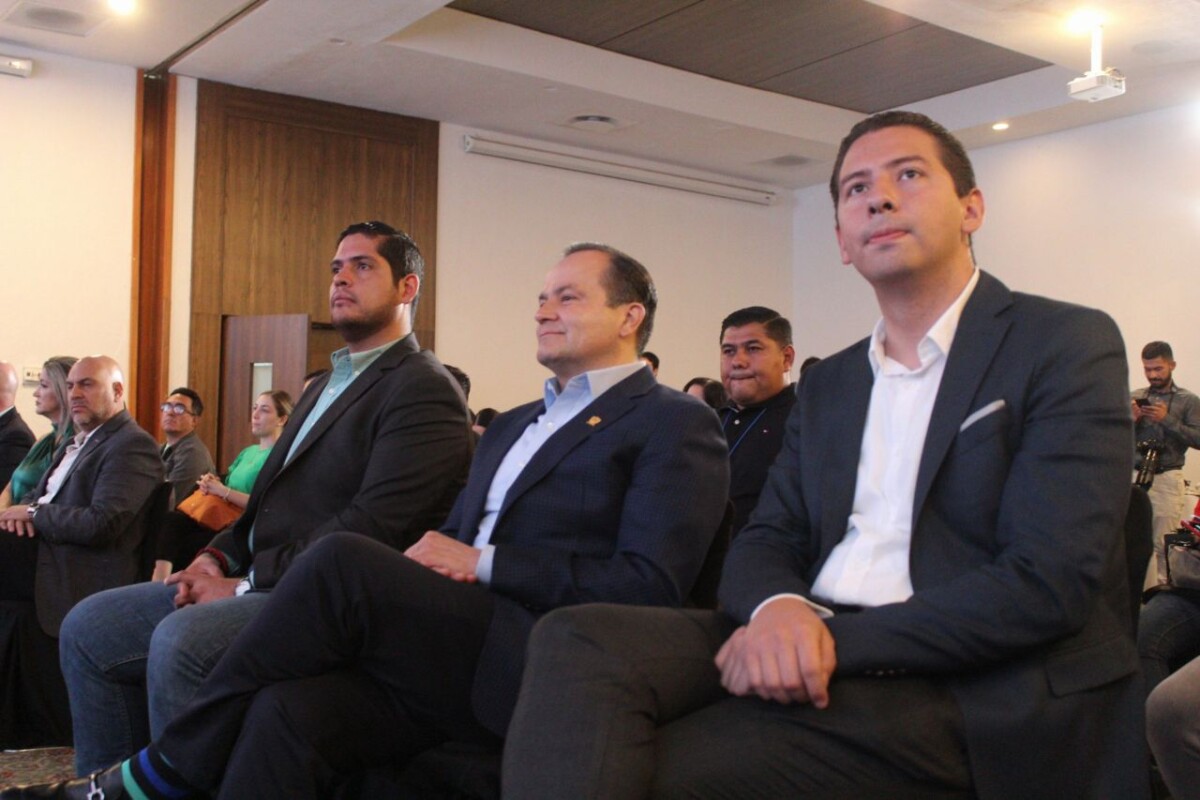
Alejandro Aguirre during the presentation conference of the XXIX Encuentro Internacional del Mariachi y la Charrería.
On August 27 and 28, 15 teams will participate in the Charro Championship will be held at the «Los 3 Potrillos» horse track on the highway between Chapala and Guadalajara.
This year event organizers plan to continue with live broadcasts, as was done during the pandemic, to reach approximately 13 million viewers from 50 countries in four continents: America, Europe, Asia and Oceania.
The Mayor of Chapala thanked the Chamber of Commerce; Lourdes Ariadna González Pérez, Secretary of Culture; and Vanessa Pérez Lamas, Secretary of Tourism of Jalisco, for their support for Chapala’s participation in major international events such as the International Mariachi Encounter.
Translated by Patrick O’Heffernan
Jocotepec expects a larger federal budget
José Miguel Gómez López during the last Popular Consultation of the Fiscal Pact on November 27 and 28, 2021. Photo: Archive.
Editorial Staff.- José Miguel Gómez López, the municipal president of Jocotepec, said he supports the revision of the Fiscal Coordination Agreement for Jalisco sent by the Jalisco Executive and approved by the State Congress. He said the municipality contributes much more than it receives.
Gómez López said of all the taxes Jocotepec contributes to the federation each year, only 15 million pesos are returned to the public budget. Jocotepec has 195 million pesos in expenses per year (almost US$10 million).
He also said that Jocotepec is one of the municipalities most affected by the current fiscal pact. With more than 200,000 hectares producing berries, among other economic activities that “generate an extraordinary amount of resources,” the amount returned to the municipality is irregular.
Gómez López said that by “refusing to sign” the Fiscal Pact agreement the worst scenario would be a budget cut and “we would still be better off.”
Jalisco is not seeking to withdraw from the Fiscal Pact but to establish a new distribution scheme for taxes generated in the states. This is based on the size of the resources that each entity contributes to the national economy according to its economic strength, needs and current challenges. The Government of Jalisco has a new and balanced vision of what should be fairly distributed to each state.
At the end of last year, a referendum was held in the state regarding a revision of the Fiscal Pact, but it did not have the required minimum participation to become binding. The southeast region had only 25.40 percent of citizen participation, while 33 percent was needed.
Translated by Mary Woods
Underground electrical installation proposed for the Chapala boardwalk commercial area
Merchants and public officials during the project presentation May 31.
Jazmín Stengel (Chapala). After some electrical fires in boardwalk commercial stalls, the City Council is looking to put the electrical lines underground. Additionally, they will reorganize the registration and permits of the stallholders.
The coordinator of Economic Development in Chapala, María de la Luz Mendoza Huerta, the director of Regulations, Sergio Armando Real Serrano, and the chief of staff, Joaquín Huerta Barrios, presented a document based on safety reports from the Federal Electricity Commission (CFE) and the Municipal Fire Department and Civil Protection.
Without legal representatives or CFE engineers present to explain the technical reasons, María de la Luz Mendoza only showed a couple of photographs as evidence of the report sent by the federal agency to the municipality after the fire on May 6, caused by an electrical overload in one of the commercial premises.

Central corridor of the commercial area of the Chapala boardwalk.
The safety report issued by the CFE urged the municipality to fix the electrical installation within a week, or the service would be cut off. The Municipality negotiated to have more time to carry out the work and to establish a dialogue with the merchants in the area.
The CFE’s recommendation dictates that the wiring of the electrical installations must be hidden and compliant. The Government of Chapala proposed that the merchants and the CFE-approved electrical engineers coordinate the work; the authorized engineer will evaluate the situation and the materials necessary to reinstall the upgraded electrical system and advise the merchants.
It is expected that the installation of the new power lines will be underground. Although the budget for the work has not been disclosed, the material will be paid for by the tenants, while City Hall will provide the labor from the Public Works Department.
The merchants asked for the area to be kept under surveillance since there have been robberies, even «they have stolen the cables from my shop», said one merchant present. In response, the reactivation of the small security booth located on the Chapala boardwalk was added to the proposals.
A letter of commitment will also be signed with the person in charge of the meter centers to avoid theft of electricity among neighbors. Many of the current connections are clandestine.
The director of Regulations, Sergio Real, said that while collecting electrical installation documents from the tenants, he will also update the merchant registration lists.
The goal is for all the merchants to have current permits, although the official did not specify exactly when. It is estimated that more than 300 vendors use the commercial area. The first registry from 2006 has only 132 merchants, plus a large number of street vendors, and more than 100 were granted permits during the 2018-2021 administration, many others work clandestinely.
Translated by Paul Weeks
80th anniversary of the Navy in Chapala commemorated with poetry and recognition
Officers of the Chapala Port Captaincy, as well as municipal authorities and service providers, commemorated the Navy Day with a civic act where poetry was recited and they asked to work as a team for the well-being of the Lakeside municipality. Photo: Mr. Arturo Ortega.
Staff (Chapala).- With poetry and recognition of the Navy sailors have helped protect the security Lakeside, , the 80th anniversary of the commemoration of the Navy Day was celebrated on June 1 in Chapala.
Those present, in addition to remembering the most important historical dates of Lake Chapala, offered an arrangement of flowers for sailors who died in the line of duty. «For us it is the “Chapalico Sea,” we have sailed in its waters and adventured in its waves», acknowledged one of those present.
Luis Jorge Ochoa Ochoa, former port captain in Chapala, recited the poem «Cruel Sea» by Gustavo Rueda Medina in commemoration of the Navy’s 80th anniversary, next to the ancient tree El Zalate de Felisa, on the Chapala boardwalk.

Officers of the Chapala Port Captaincy, as well as municipal authorities at the Chapala boardwalk.
«The Mexican Navy has been and is for Mexicans, not only the guarantee of national sovereignty in our waters, but a source of pride and deep respect,» acknowledged municipal president Alejandro de Jesús Aguirre Curiel.
To conclude the commemoration, the sailors offered a wreath for the comrades who died in Lake Chapala, which was placed in front of the lighthouse.
The port captaincy in Chapala has been present at the lakeside municipality for more than 25 years.
Translated by Kerry Watson
City Hall announces investments of more than 13 million pesos in social works for Chapala, Ajijic and Atotonilquillo
Chapala President Alejandro de Jesús Aguirre Curiel (center) during the COPLADEMUN meeting and unveiling of the 2022 projects with FAIS investments.
Editor. – More than 13,778,000 pesos (about US$700,000) from the Contribution Fund for Social Infrastructure, or FAIS, will be invested this year in 13 projects for Ajijic, Atotonilquillo and the municipal capital of Chapala.
Details and budget amounts were announced during the May 31 meeting of the Committee for Municipal Development, or COPLADEMUN, at the Centro Cultural Antigua Presidencia in Chapala.
Construction and maintenance projects in Chapala will focus on Miguel Martínez, Zaragoza and Pípila streets. Architect María del Carmen Corona detailed the works to be carried out through the FAIS, starting with Miguel Martínez Street. This project includes installation of drinking water and sewage lines and the construction of a collector.
Also planned is installation of drainage lines on Zaragoza Street, construction of concrete pavement, sidewalks and trimmings in the northern part of Chapala. There are also plans for the construction of concrete pavement, sidewalks and pavers for Pípila Street, as well as rehabilitation of some other streets.
There will be three projects in the Magic Town of Ajijic, including rehabilitation of the Six Corners square at a cost of 652,000 pesos (about US$33,000). Also, firm floors will be installed in homes that need them the most. Crosswalks will be installed at the intersections of Juárez and Ángel Flores, Zaragoza and Juárez, Juárez and Ocampo, Hidalgo and Juárez, Constitución and Marcos Castellanos, Constitución and Aldama, Guadalupe Victoria and Aldama, Hidalgo and Álvaro Obregón, and Zaragoza and Hermenegildo Galeana.
Finally, the delegation of Atotonilquillo will have a budget of 500,000 pesos (about US$25,000) for the rehabilitation and maintenance of streets and sidewalks.
During the meeting, the mayor of Chapala swore in 24 of the 32 members of COPLADEMUN for the period 2021-2024. The group is made up of municipal authorities, citizens, businessmen, representatives of educational institutions, indigenous communities and others.
Translated by Mike Rogers
Suma Jalisco 29 casos y un fallecimiento por influenza en lo que va de la temporada
Hasta el 11 de junio, la SSJ reportó 29 casos acumulados de influenza, cuyo tipo predominante es el AH3N2. Foto: Internet.
Redacción.- La Secretaría de Salud Jalisco (SSJ) reportó hasta el 11 de junio 29 casos acumulados de influenza en lo que va de la actual temporada interestacional 2022, en la cual el virus circulante que más predomina es el tipo AH3N2; un comportamiento que se está registrando en el país.
Del total de contagios acumulados, en la semana número 23 de 2022 se reportaron 18 casos nuevos de influenza y una defunción en Jalisco, la cual es la primera que se notifica este año y corresponde a un masculino de 79 años de edad, residente de Guadalajara. El paciente no estaba vacunado y como antecedente de riesgo reportaba otras enfermedades (diabetes, hipertensión, obesidad, tabaquismo).
Los municipios con mayor número de casos son Zapopan (11), Guadalajara (6), Colotlán (2), Tamazula (2) y Tlaquepaque (2), que representan el 79% del total.
La temporada de influenza interestacional comprende de la semana epidemiológica 21 a la semana 39 de este año. Y, aunque en esta época baja la incidencia de casos respecto a la temporada invernal, la dependencia recordó que los virus continúan circulando, por lo que ante síntomas respiratorios recomienda acudir a atención médica, para recibir un diagnóstico adecuado y atención oportuna.
La SSJ informó que durante la campaña invernal 2021-2022 en Jalisco se hicieron estrategias para la prevención de la enfermedad a través de estrategias para la aplicación de la vacuna contra influenza y reforzar medidas preventivas, como ejemplo se invitó a seguir la Ruta de la Vacuna, en medio de la contingencia por COVID-19, que consistió en asistir a los centros de salud, hospitales y centros médicos con protocolos para reducir el riesgo de contagios; en los Módulos y Macromódulos de vacunación contra COVID-19 se aplicó vacuna contra Influenza también priorizando grupos vulnerables.
De esta manera, en dicha temporada 2021-2022 fueron aplicadas 2 millones 217 mil 944 dosis de vacuna contra influenza, con un logro del 100% con respecto a la meta de la vacuna distribuida por la federación para Jalisco. Vacunarse es una medida preventiva eficaz para los grupos de riesgo.
A nivel nacional, en la temporada de influenza interestacional, al corte de la semana 23, se han registrado un total de 152 casos.
La SSJ llama a seguir las medidas preventivas para favorecer la prevención de enfermedades respiratorias como la Influenza, con base a las siguientes recomendaciones:
- La forma más eficaz de prevenir la Influenza es la vacunación.
- Lavarse las manos frecuentemente y secárselas bien.
- Mantener una buena higiene respiratoria, cubriéndose la boca y la nariz al toser o estornudar (con ángulo del codo o con pañuelos y desecharlos correctamente).
- Evitar el contacto con personas enfermas.
- Evitar tocarse los ojos, la nariz y la boca.
- Evitar cambios bruscos de temperatura.
- Ingerir alimentos ricos en vitaminas A y C.
- Aislarse rápidamente en caso de malestar, fiebre u otros síntomas gripales.
After a year and a half, the water well in the west of Ajijic is finally working!
Municipal President and SIMAPA officials during the announcement that the well would be connected to the potable water network. Photo: Government of Chapala.
Sofía Medeles (Ajijic).- The well on the outskirts of Ajijic was put into operation at the end of last week, after approximately a year and a half of drilling, and will supply the areas from La Cristina to Alceseca, to the west of the town.
The person in charge of the Municipal System of Potable Water and Sewage (SIMAPA) Ajijic, Timoteo Aldana Pérez, said that although it does not have the expected capacity, the water is suitable for consumption and sufficient to cover the needs of the area.
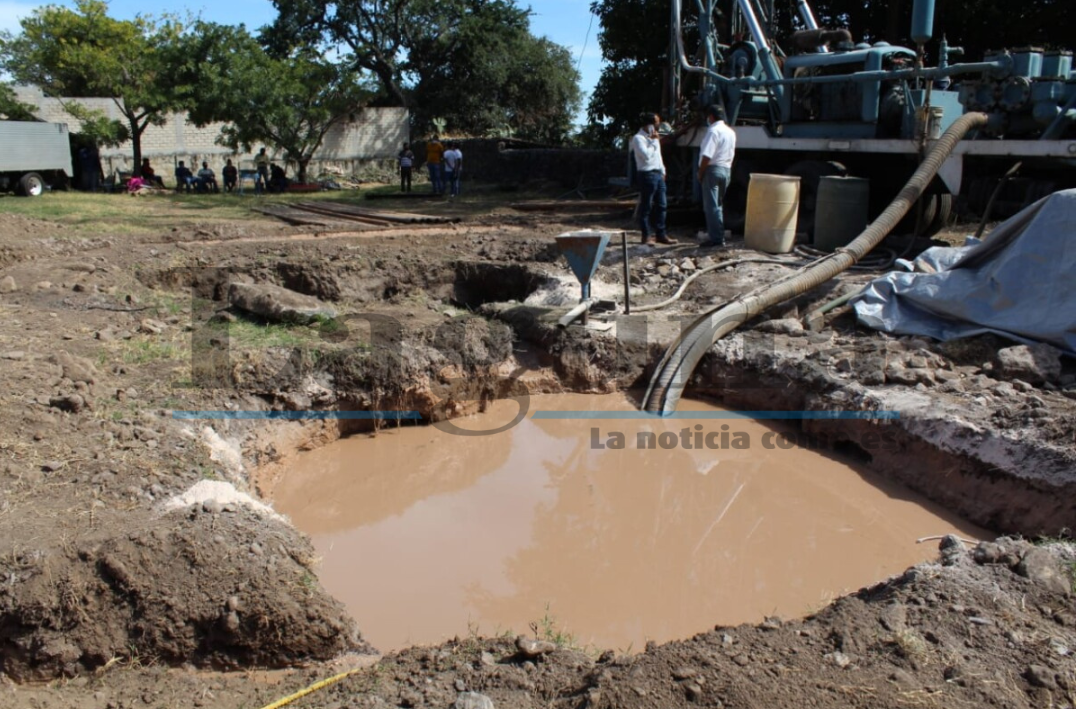
The wells shortly after being drilled in 2020. The well is located in the area of La Mojonera and will supply water from La Cristina to Alceseca. Photo: Sofía Medeles.
«The well produces less water than we expected. Normally the capacity of the other wells ranges from 33 to 16 liters per second, but this one gives between eight and ten. It is not what we expected, but it is enough water for the area. We hope that with the rainy season it can improve,» said Aldana Pérez.
He also said that the low capacity of the well could be due to the fact that the bentonite -material used to avoid or reduce landslides in the wells- that was used during its drilling has not yet been completely cleaned. «It’s a matter of waiting to get it all out,» he mentioned.
He added that this well is the deepest of all the wells in Ajijic and the drilling expenses were assumed by the past administration. This administration was in charge of the electrification and the placement of the pumping system, and although he does not know the total cost of the well, he commented that he estimates it could be approximately three million pesos.
Neighbors of the zone said that the operation of the new well is already noticeable.
«Yes, there has been water for more days, although not all day. Before there was water two or three days a week, and now up to six days,» commented José Rosario, who lives in the Alceseca area.
On the other hand, one of the interviewees, an inhabitant of La Cristina, to the west of Ajijic, commented that she has noticed the change, however, the water has been more cloudy with a whitish color.
The well is located in «Rancho San Vicente», on the municipality’s borders. This was announced by the last administration (2018-2021), where the then municipal president Moisés Alejandro Anaya Aguilar stated in November 2020 that the well was already drilled, however, it was not actually completed in his administration.
Translated by Patrick O’Heffernan
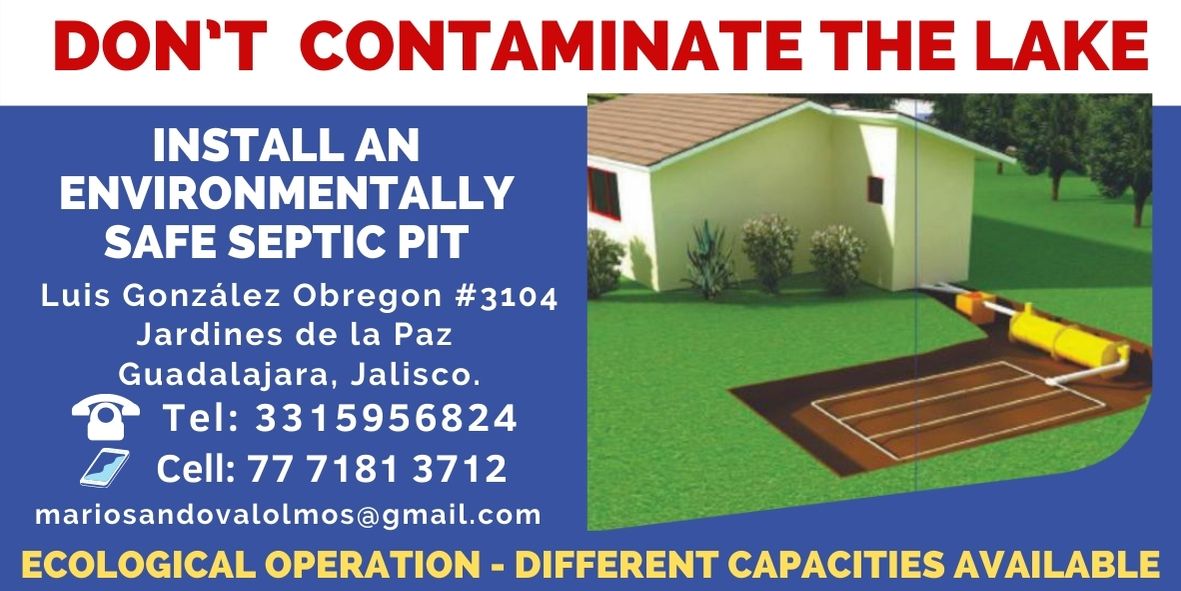
Mantiene Jalisco obligatoriedad de verificación vehicular; multas iniciarán a partir de 2023
El programa seguirá siendo de cobertura estatal, pero obligatorio para quienes vivan en el AMG y en ciudades medias y sus zonas metropolitanas. Foto: Gobierno de Jalisco.
Redacción.- El Gobernador del Estado de Jalisco, Enrique Alfaro Ramírez, anunció el pasado 7 de junio que el Programa de Verificación Responsable mantiene su carácter obligatorio, pero con un enfoque de incentivos más que de sanciones.
El mandatario reiteró que no se aplicarán sanciones hasta que se cuente con las condiciones necesarias para que los usuarios realicen su verificación sin ninguna complicación, es decir, cuando el sistema de citas sea más amigable e intuitivo al utilizar y cuando la capacidad instalada del programa sea de por lo menos 80 líneas en el AMG y dos en cada una de las ciudades medias que estarán obligadas.
“Este año no hay multas, lo que hay son incentivos para que la gente entienda que verificar es una responsabilidad de todos y tenemos que poner cada quien de nuestra parte para cuidar el medio ambiente. Con esto queremos dejar en claro que el propósito del programa no es recaudar más dinero, lo que queremos es que dejemos de contaminar”, dijo el mandatario.
Respecto a los ajustes, Alfaro también precisó que, aunque el alcance de la Verificación Responsable seguirá siendo estatal, solo será obligatorio para quienes vivan en el AMG y en ciudades medias y sus zonas metropolitanas como Puerto Vallarta, Lagos de Moreno, Tepatitlán, Ocotlán y Ciudad Guzmán.
Además, los vehículos de uso intensivo estarán verificando solamente una vez al año, en lugar de dos, tal como es en el caso de los vehículos particulares. Para la aplicación de dichos ajustes, se enviará al Congreso de Jalisco una reforma al decreto del Programa de Verificación Responsable.
“Estamos hablando de 2.8 millones de vehículos obligados a verificar y si tú vives en Guadalajara o en cualquier ciudad media, tendrás la obligación de verificar tu vehículo y de ayudar a dejar de emitir contaminantes en la atmósfera”, comentó el Gobernador.
Asimismo, Alfaro Ramírez señaló que la bolsa alcanzada en el fondo ambiental, cuya estimación es de 110 millones de pesos al final de este ejercicio fiscal, se destinará a proyectos como la modernización de la red de monitoreo de calidad del aire en el AMG, la creación de un programa de renovación y chatarrización, fortalecimiento del programa de conservación de la biodiversidad y un programa integral de resiliencia hídrica en las ciudades medias del estado que incluye acciones en Lagos de Moreno, Tepatitlán, Puerto Vallarta, Ocotlán y Zapotlán el Grande.
En este momento, Jalisco cuenta con 53 líneas de verificación distribuidas en 11 Centros de Verificación Responsable (CVR) y una línea móvil, capacidad instalada para verificar a 183 mil 168 vehículos al bimestre de acuerdo al calendario mes-placa, además, se están en proceso de construcción 79 líneas más, que han sido el resultado de cuatro convocatorias.
Hasta el 5 de junio de 2022, se han aplicado 267 mil 405 pruebas de verificación vehicular, de las cuales 168 mil 966 pruebas corresponden a este año, con un porcentaje de aprobación del 90%.
Antes de la implementación de este ejercicio, se agendaban entre 400 y 600 citas diarias, mientras ahora, el promedio es de 2,676 citas por día.
Para agendar una cita, los usuarios solo deben ingresar al sitio web: verificacionresponsable.jalisco.gob.mx y dar click en el botón “hacer cita”, seleccionar el Centro de Verificación Responsable deseado, elegir fecha y horario, ingresar los datos del formulario su (la información solicitada está en la tarjeta de circulación) y realiza tu pago.
Plaza in El Chante remains empty and unfinished
The new main plaza, in broad daylight, is empty and without shade to protect from the sun. Photo: Héctor Ruiz.
Héctor Ruiz Mejía (Jocotepec).- Residents of the community of El Chante, in Jocotepec asked the City Council for support for the completion of the main square project. The rehabilitation project consisted of the construction of a kiosk, a new local town office, public restrooms and multiple benches.
After an investment of ten million pesos (over US$500,000), with funding from the Common Competitive Fund for Infrastructure (FOCOCI) and managed by the Jalisco Public Works Infrastructure Secretariat (SIOP), there are still «details to be fine-tuned,» as some residents pointed out.
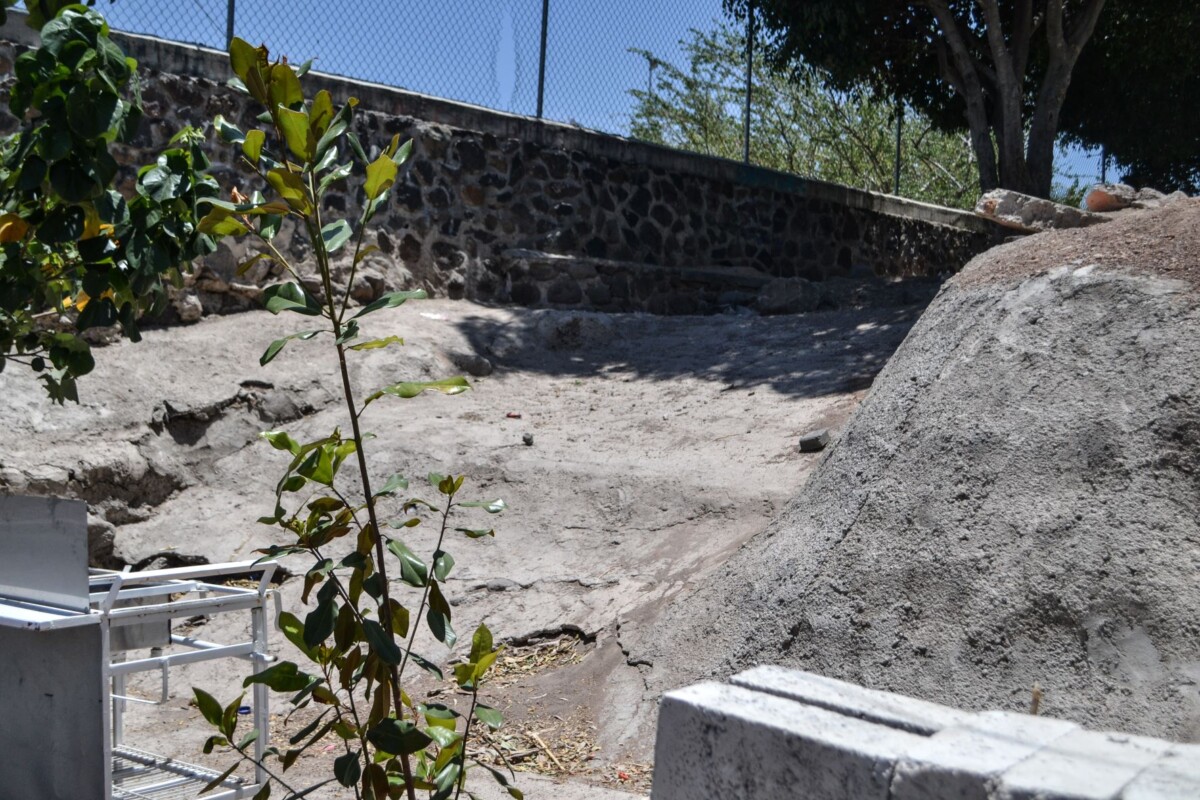
The place where stairs were originally planned is now a dangerous »dirt ramp», where more than one has fallen, according to neighbors. Photo: Héctor Ruiz.
The fact that the sun shines on the plaza from approximately 11:00 in the morning until 5:30 in the afternoon, without any shade to help protect against the heat, means that the space remains empty and unused during those hours.
«Well, we are happy because in all my years here, there was rarely anyone who put money into it and now it looks much better than it was before. But before, we could take out chairs and sit out until the afternoon, when the sun goes down,» commented Maria, who lives almost in front of the public space.
«They should put something – more trees or some awnings. They say they want to put some games here, but who is going to play outside with this sun?,» commented another of the neighbors, who preferred to keep her name anonymous.
The lack of shelter from the inclement sun was not the only issue that previous users of the space pointed out: just at the border of the plaza with the Encarnación Rosas School, there is a «poorly made ditch,» where a stairway was planned to go.
The structure, which was originally planned to be a stairway, is now only an uneven ramp of dirt and gravel which has already caused more than one passerby to slip.
«They should have put some stairs or a proper ramp there. People have already fallen, especially drunks and children, they are the ones who fall the most. Besides, in rainy weather, all the gravel slides and it becomes even more dangerous,» commented another of the residents.
They added that it wouldn’t hurt to give the much-loved kiosk a «facelift» since the bricks used to build the structure still stand out, and they say that «a little tidying up would make the view of the only square more pleasant.»
The project was inaugurated on February 27, 2021, after being postponed several times due to the pandemic.
Translated by Rebecca Zittle
© 2016. Todos los derechos reservados. Semanario de la Ribera de Chapala
